Interaction between Groundwater and Rock Fractures under Stress and Seepage Based on Extractive Water Resource Utilisation
Abstract
:1. Introduction
2. Sample Preparation and Test Programme Design
2.1. Experimental Equipment
- (1)
- Shear strength tests of rock samples. Before conducting any seepage experiments, it is crucial to determine the shear strength of the various rock samples. It can also help us to study the damage to rough fracture surfaces of rocks of different strengths under water-force coupling. The insights derived from these tests will provide foundational knowledge for understanding the evolution of seepage channels.
- (2)
- Rough fracture seepage experiments. In the experiment, we will couple the stress field with the seepage field to investigate the seepage characteristics of the rock fractures and the fracture damage law.
- (3)
- 3D topographic scanning. This scan is performed on the fracture surface of each sample, both pre- and post-seepage experiment.
2.2. Sample Preparation
2.3. Experimental Programme
3. Seepage Characteristics of the Rough Fractures under Different Shear Stresses
3.1. Shear Strength Characteristics of Different Rock Masses
3.2. Seepage Characteristics of Rough Fractures under Different Water Pressures
3.3. Study of the Coupled Effect of Shear Stress and Displacement on Seepage Characteristics of Rough Fractures
4. Analysis of the Change Rule of Rough Fracture Morphology Characteristics under Hydraulic Coupling Effect
4.1. Erosion Damage Mechanism of Rough Fractures under Hydraulic Coupling Action
4.2. Changing Law of Rough Fracture Morphology under Hydraulic Coupling Effect
4.3. Characterisation of Rough Fracture Damage under Hydrodynamic Coupling
5. Conclusions
- When seepage occurs within the rough fractures of coal, sandstone, and concrete, there is a nonlinear proportional increase in seepage pressure and seepage flow. Under the same stress conditions, the seepage velocity of the three materials is as follows: concrete > sandstone > coal. Due to the more obvious laminar structure of coal, it has a hindering effect on the seepage flow in the fractures. The decrease in seepage velocity in rough fractures of rock masses with larger shear strength is smaller, and the decrease in seepage velocity in rough fractures of rock masses with smaller shear strengths is larger.
- With the increase in shear stress on the sample under the same conditions of surrounding pressure and seepage pressure, the rough fracture permeability of sandstone and concrete decreases, while the permeability of coal has a significant increase. This is due to the obvious laminar nature of coal and the non-homogeneous nature of the rough fractures in the occurrence of shear slip along the direction of laminar sliding, so that the fracture openings increased and permeability increased. Under the same conditions, the permeability difference between coal and sandstone and concrete is about ten times. The effect of shear stress–seepage coupling on the rough fracture permeability of coal, which has more obvious laminations, is about two times the effect of normal stress–seepage coupling on permeability, and the form of stress action on sandstone, concrete, and this kind of rock mass has less effect.
- The mechanism of rock erosion damage under water-force coupling action is that the raised contact between the fracture surfaces of the rock mass will be sheared and broken with shear sliding, and the resulting raised broken material will roll, micro-fracture, abrade, and be spatially redistributed with shear, which in turn affects the seepage and strength characteristics of the fracture. Due to the destruction and shedding of particles in the seepage pressure driven by the transport on the fracture surface, the fracture morphology characteristics will change, as will the original seepage channel of the fracture. This part of the rock particles, when transported to the narrow area of the fracture, will produce a filling effect on the fracture. When the fracture contacts the surface extrusion, shear will exacerbate the fracture surface due to the hydrodynamic coupling of erosion damage, thus further changing the seepage characteristics of the rock mass fracture.
- Under shear stress and seepage erosion coupling, the destructive effect for the rock mass fracture morphology is significantly stronger than under the normal stress–seepage erosion phase coupling. In addition, under the same conditions, the degree of change in fracture morphology (fracture damage) of different rock masses is coal > concrete > sandstone.
- The 3D morphology scanning technique provides a better representation of the geometric features of the fractures. These data can help us to quantitatively analyse the erosion damage of rock fractures. However, there are some limitations; for example, this method can only obtain the fracture morphology data before and after the test. Real-time monitoring during the experiment cannot be completed. In addition, the stress environment in which the underground rock is located in the actual situation is very complex, and the triaxial experimental method of isoperimetric pressure cannot simulate this situation well. It is necessary to increase the study of rocks containing fractures under true triaxial conditions due to the existence of non-homogeneity and anisotropy factors within coal and some other rocks having an effect on the fracture seepage [33]. In contrast, most current coal seepage studies do not consider the dynamic changes in permeability during seepage caused by stress changes [34]. In the next step, we can consider studying the structural change and stress change of coal and exploring the dynamic change law of permeability at each stage of the seepage process under the influence of anisotropy and other factors.
Author Contributions
Funding
Data Availability Statement
Conflicts of Interest
References
- Yao, Q.; Hao, Q.; Chen, X.; Zhou, B.; Fang, J. Design of coal pillar dam width for underground reservoir in coal mine. J. Coal 2019, 44, 891–899. [Google Scholar]
- Xu, J.L.; Zhu, W.B.; Wang, X.Z. A method for predicting the height of hydraulic fracture zones based on the location of key layers. J. Coal Sci. 2012, 37, 762–769. [Google Scholar]
- Yao, Q.; Tang, C.; Liu, Z. Analysis of coal-water co-mining in ecologically fragile mines in western China. Coal Sci. Technol. 2021, 49, 225–232. [Google Scholar]
- Dazhao, G. Theoretical framework and technical system of coal mine underground water reservoir. J. Coal Sci. Technol. 2015, 40, 239–246. [Google Scholar]
- Xie, H.; Xu, W.-L.; Liu, C.; Yang, X.-G. Strategic concept and key technology outlook of underground hydraulic engineering. J. Rock Mech. Eng. 2018, 37, 781–791. [Google Scholar]
- Qiao, W.; Li, W.; Li, T.; Chang, J.; Wang, Q. Effects of Coal Mining on Shallow Water Resources in Semiarid Regions: A Case Study in the Shennan Mining Area, Shaanxi, China. Mine Water Environ. 2017, 36, 104–113. [Google Scholar] [CrossRef]
- Li, P.; Wu, J.; Tian, R.; He, S.; He, X.; Xue, C.; Zhang, K. Geochemistry, Hydraulic Connectivity and Quality Appraisal of Multilayered Groundwater in the Hongdunzi Coal Mine, Northwest China. Mine Water Environ. 2018, 37, 222–237. [Google Scholar] [CrossRef]
- Olsson, R.; Barton, N. An improved model for hydromechanical coupling during shearing of rock joints. Int. J. Rock Mech. Min. Sci. 2001, 38, 317–329. [Google Scholar] [CrossRef]
- Jing, L.; Hudson, J.A. Numerical methods in rock mechanics. Int. J. Rock Mech. Min. Sci. 2002, 39, 409–427. [Google Scholar] [CrossRef]
- Detwiler, R.L.; Rajaram, H. Predicting dissolution patterns in variable aperture fractures: Evaluation of an enhanced depth-averaged computational model. Water Resour. Res. 2007, 43. [Google Scholar] [CrossRef]
- Le Borgne, T.; Ginn, T.R.; Dentz, M. Impact of fluid deformation on mixing-induced chemical reactions in heterogeneous flows. Geophys. Res. Lett. 2014, 41, 7898–7906. [Google Scholar] [CrossRef]
- Dijk, P.E.; Berkowitz, B. Buoyancy-driven dissolution enhancement in rock fractures. Geology 2000, 28, 1051–1054. [Google Scholar] [CrossRef]
- Wu, Y.Q. Groundwater and geological hazards. Undergr. Space 1999, 4, 303–310. [Google Scholar]
- Xia, C.; Wang, W.; Cao, S. Seepage characteristics of joints under different contact states. J. Rock Mech. Eng. 2010, 29, 1297–1306. [Google Scholar]
- Fu, Y.; Wang, Z.; Liu, X.; Yuan, W.; Miao, L.; Liu, J.; Deng, Z. Study of fine-scale damage evolution and macroscopic deterioration of sandstone under dry and wet cycling. J. Geotech. Eng. 2017, 39, 1653–1661. [Google Scholar]
- Feng, X.; Wang, W.; Wang, R.; Yuan, S.; Zhu, Q. An ontological model of rheological damage in sandstone considering water chemical damage. Geotechnics 2018, 39, 3340–3346. [Google Scholar]
- Yu, J.; Zhang, X.; Cai, Y.; Liu, S.; Tu, B.X.; Fu, G.F. Experimental study on the microscopic damage and mechanical property degradation of sandstone under the combined action of water chemistry and freeze-thaw cycle. Geotechnics 2019, 40, 455–464. [Google Scholar]
- Tang, L.; Zhang, P.; Wang, S. Experimental study on the macroscopic mechanical effects of water-rock chemistry on rocks. J. Rock Mech. Eng. 2002, 21, 526–531. [Google Scholar]
- Brush, D.J. Three-Dimensional Fluid Flow and Solute Transport in Rough-Walled Fractures. Ph.D. Thesis, University of Waterloo, Waterloo, ON, Canada, 2001. [Google Scholar]
- Shen, L.F.; Feng, X.T.; Pan, P.C.; Zhou, F. Experimental study of single-fissure granite under stress-seepage-chemistry coupling. J. Rock Mech. Eng. 2010, 29, 1379–1388. [Google Scholar]
- Jiang, Z.-B.; Jiang, J.-N.; Li, H. Changing law of permeability characteristics of slate through fissures in corrosive environment. J. Coal Sci. 2016, 41, 1954–1962. [Google Scholar]
- Wu, Y.; Lin, Y.; Wan, J.; Wang, Z.J. Coupled seepage-erosion model for carbonate rocks with single fissure and sensitivity analysis of its parameters. China Karst 2016, 35, 81–86. [Google Scholar]
- Hudson, J.A.; Cornet, F.H.; Christiansson, R. ISRM suggested methods for rock stress estimation-part 1: Strategy for rock stress estimation. Int. J. Rock Mech. Min. Sci. 2003, 40, 991–998. [Google Scholar] [CrossRef]
- Kou, M.M.; Liu, X.R.; Wang, Z.Q.; Tang, S.D. Laboratory investigations on failure, energy and permeability evolution of fissured rock-like materials under seepage pressures. Eng. Fract. Mech. 2021, 247, 27. [Google Scholar] [CrossRef]
- Zhao, J. Applicability of Mohr–Coulomb and Hoek–Brown strength criteria to the dynamic strength of brittle rock. Int. J. Rock Mech. Min. Sci. 2000, 37, 1115–1121. [Google Scholar] [CrossRef]
- Huang, S.; Xia, K.; Dai, F. Establishment of a Dynamic Mohr-Coulomb Failure Criterion for Rocks. Int. J. Nonlinear Sci. Num. 2012, 13, 55–60. [Google Scholar] [CrossRef]
- Singh, M.; Singh, B. Modified Mohr-Coulomb criterion for non-linear triaxial and polyaxial strength of jointed rocks. Int. J. Rock Mech. Min. Sci. 2012, 51, 43–52. [Google Scholar] [CrossRef]
- Snow, D.T. Anisotropie Permeability of Fractured Media. Water Resour. Res. 1969, 5, 1273–1289. [Google Scholar] [CrossRef]
- Zhao, Z. Gouge Particle Evolution in a Rock Fracture Undergoing Shear: A Microscopic DEM Study. Rock Mech. Rock Eng. 2013, 46, 1461–1479. [Google Scholar] [CrossRef]
- Du, S.G.; Chen, Y.; Fan, L.B. Mathematical expression of the JRC modified straight edge method. J. Eng. Geol. 1996, 4, 36–43. [Google Scholar]
- Deng, H. Mechanisms of loading rate effect on tensile strength of sandstone. Geotechnics 2018, 39, 79–88. [Google Scholar]
- Xu, J.; Wang, W.; Liu, Y.; Peng, S.; Wu, S.; Qu, J.; Xiao, Z. Experimental study on morphological characteristics of coal rock shear section under shear-seepage action. Geotechnics 2018, 39, 4313–4324. [Google Scholar]
- Menezes, F.F. Anisotropy of volume change and permeability evolution of hard sandstones under triaxial stress conditions. J. Pet. Sci. Eng. 2019, 174, 921–939. [Google Scholar] [CrossRef]
- Zhao, Y.; Lin, B.; Liu, T.; Li, Q.; Kong, J. Gas flow field evolution around hydraulic slotted borehole in anisotropic coal. J. Nat. Gas Sci. Eng. 2018, 58, 189–200. [Google Scholar] [CrossRef]
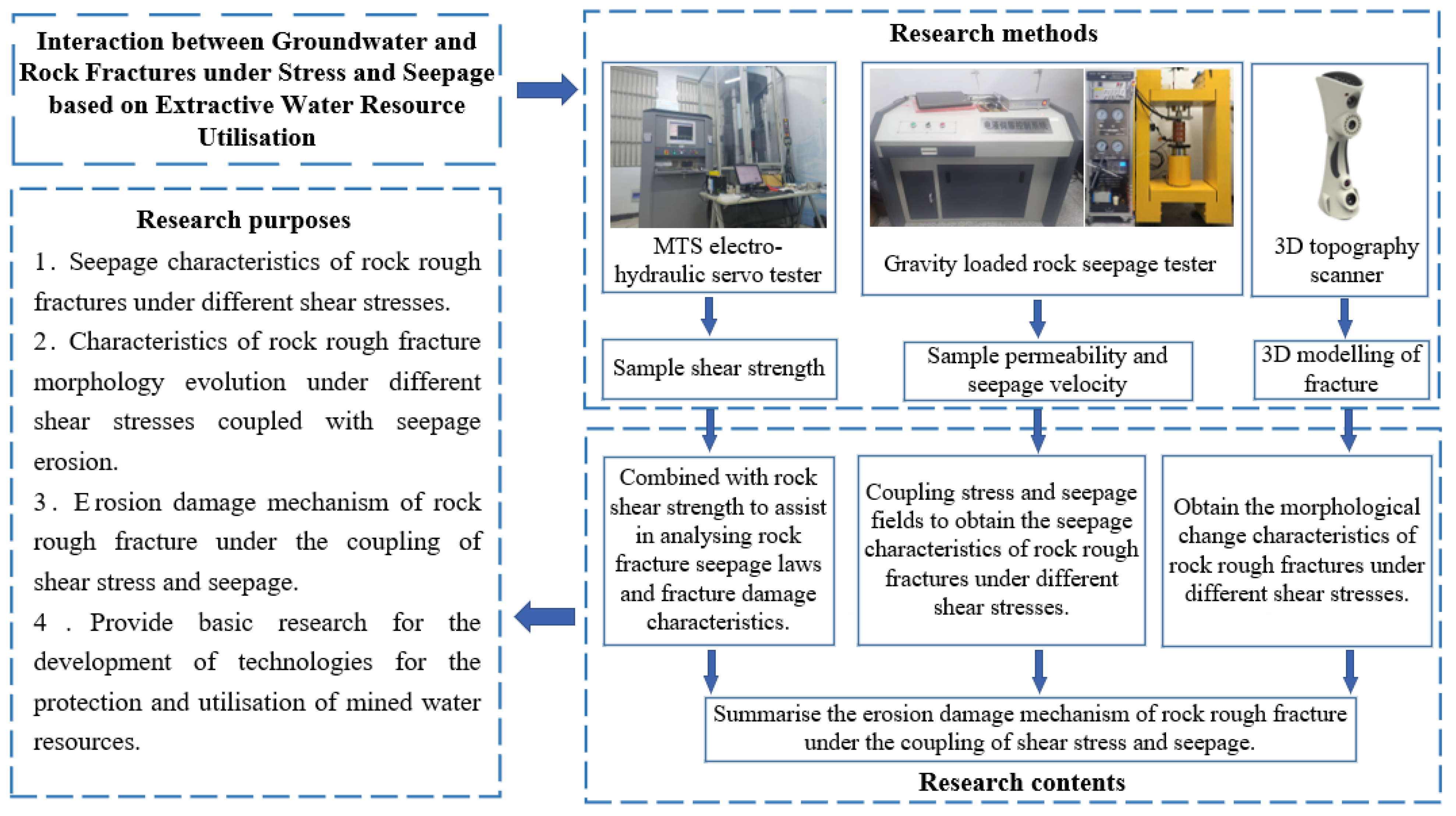


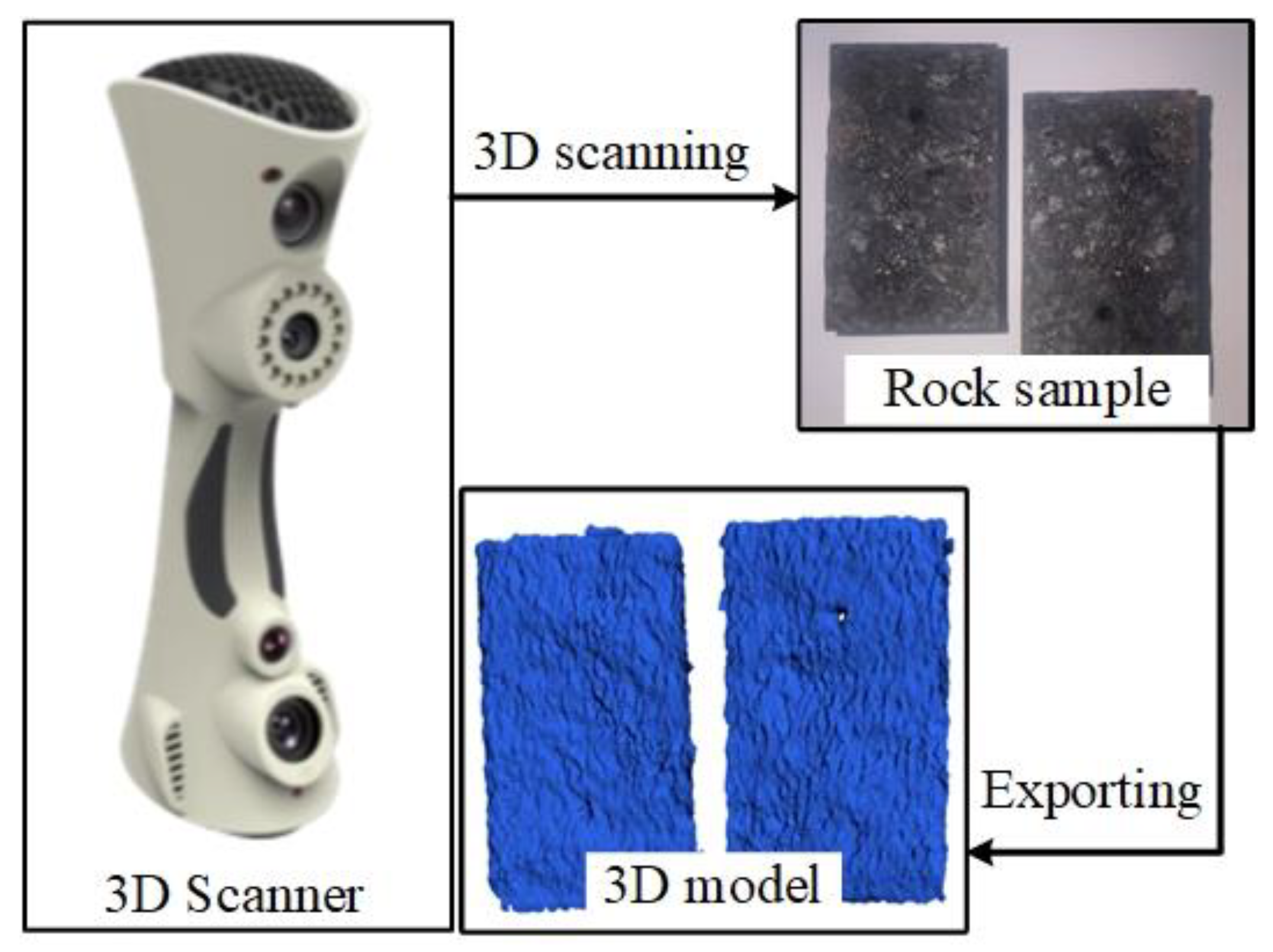
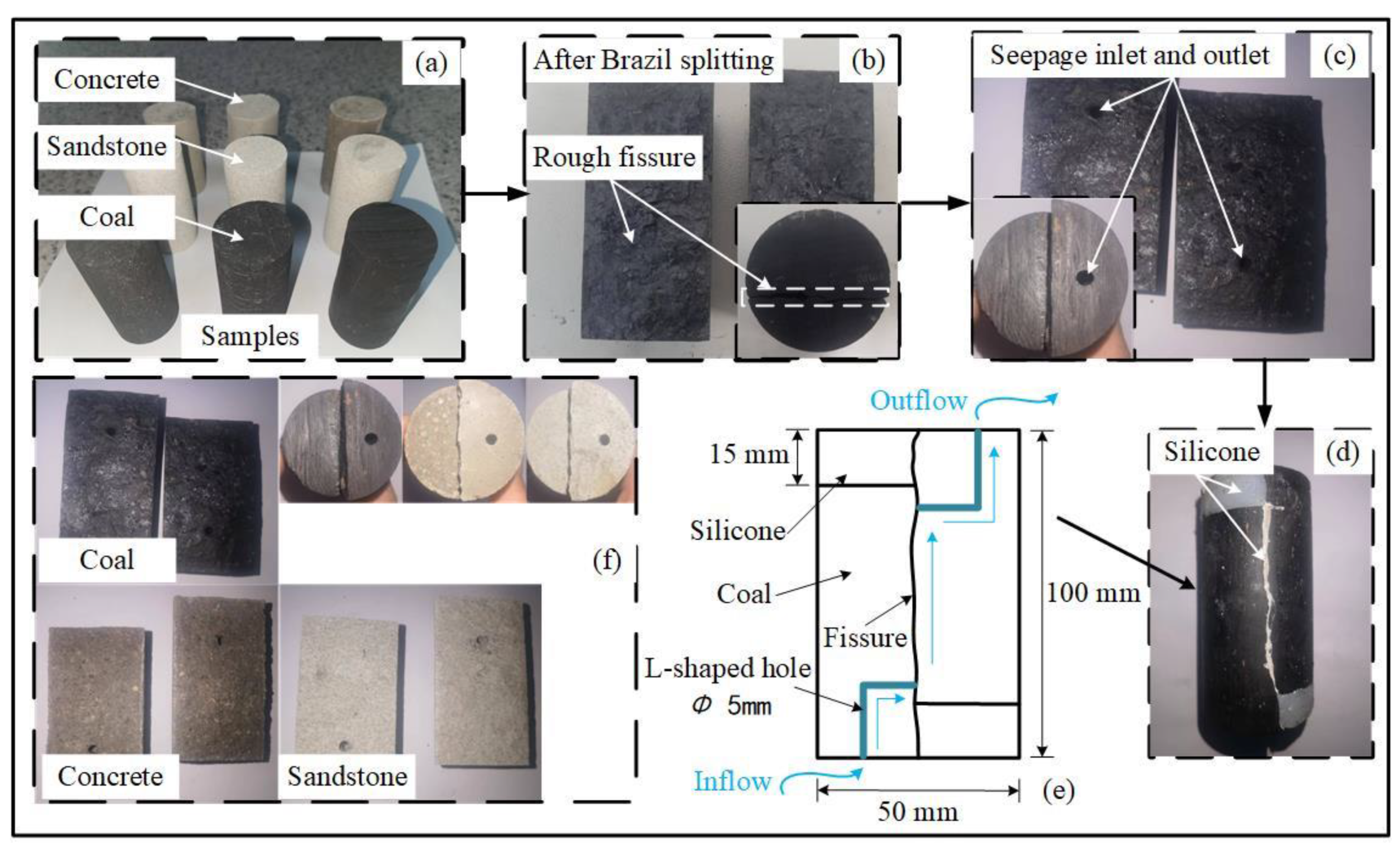
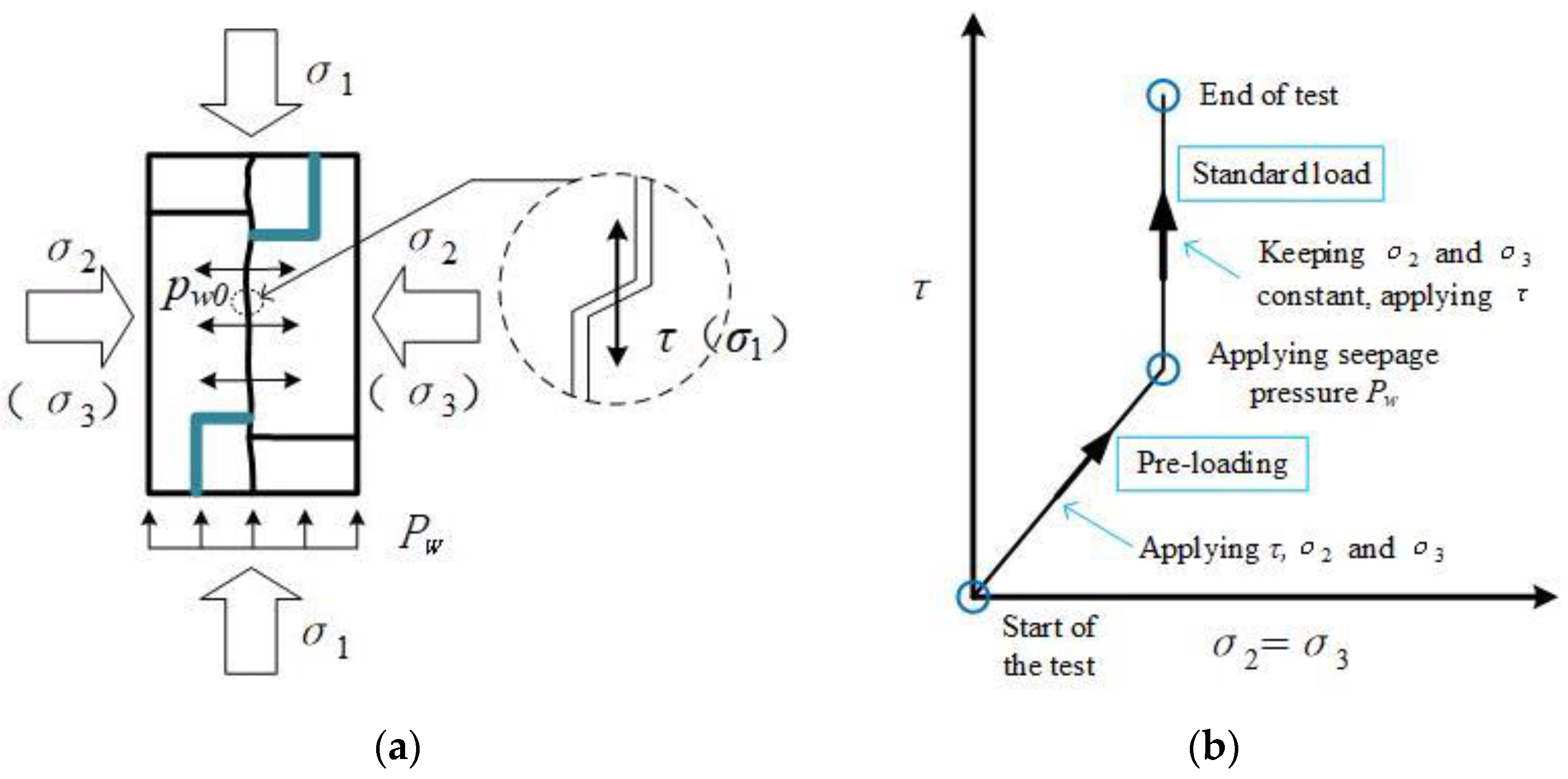
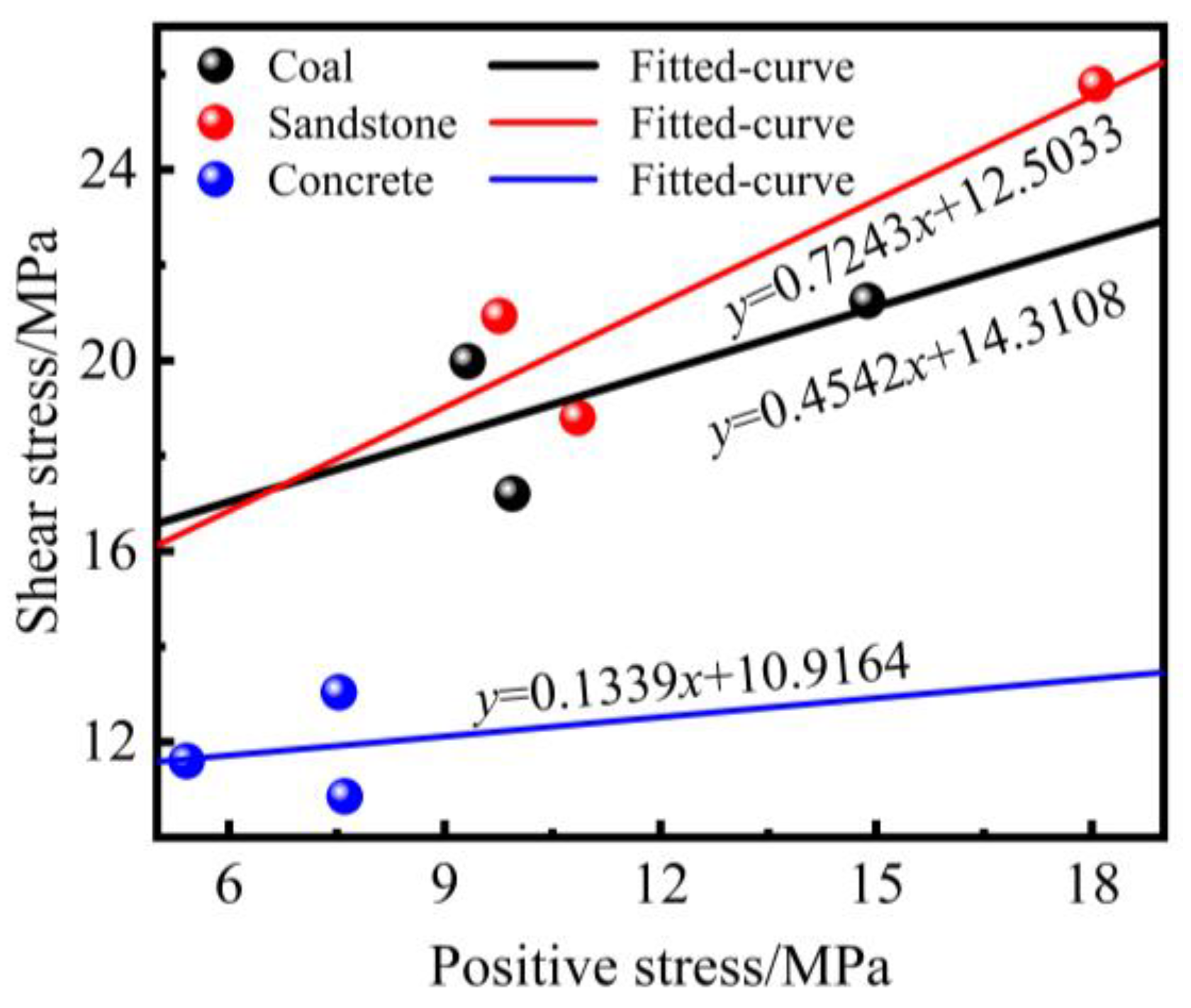
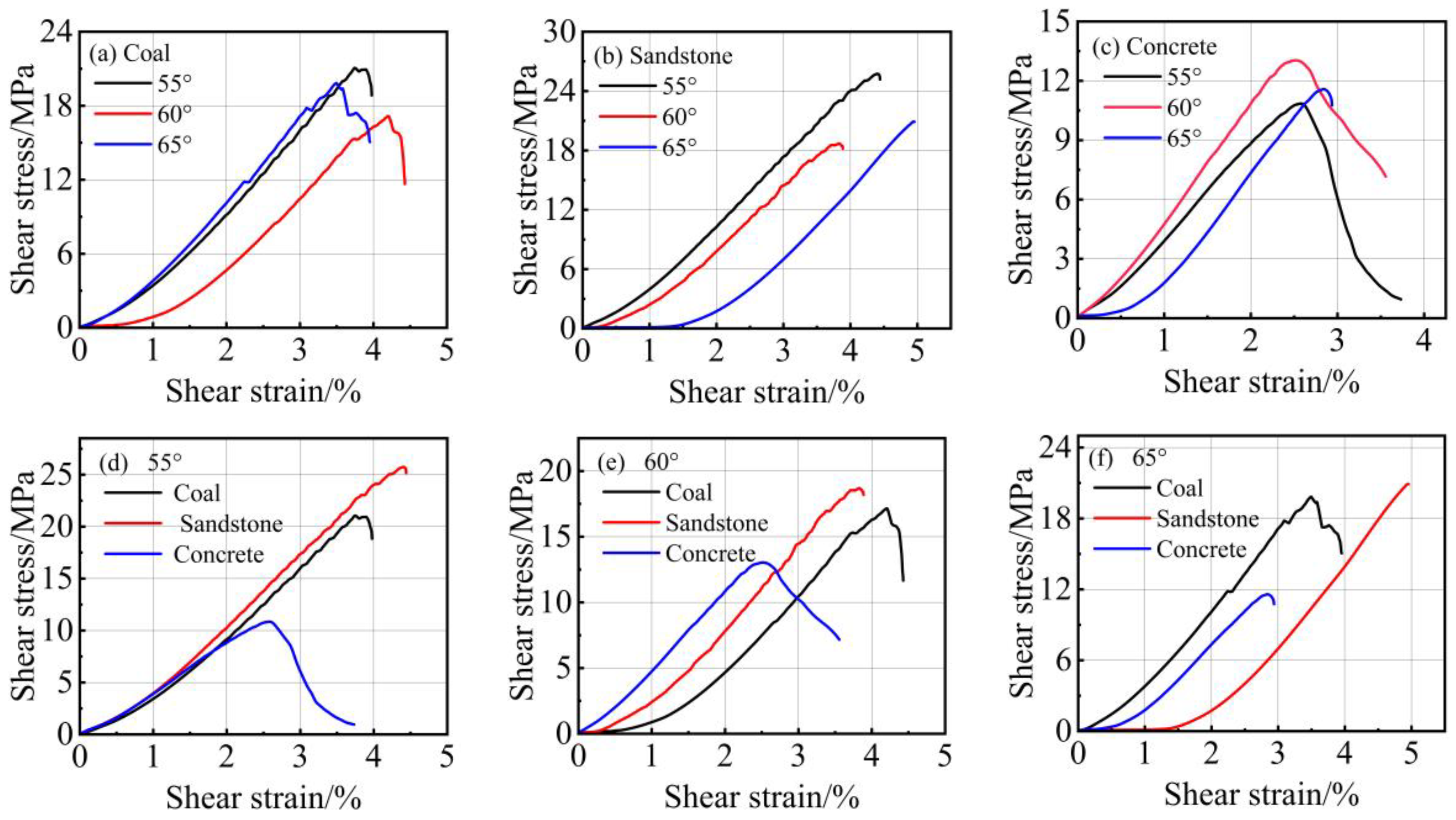







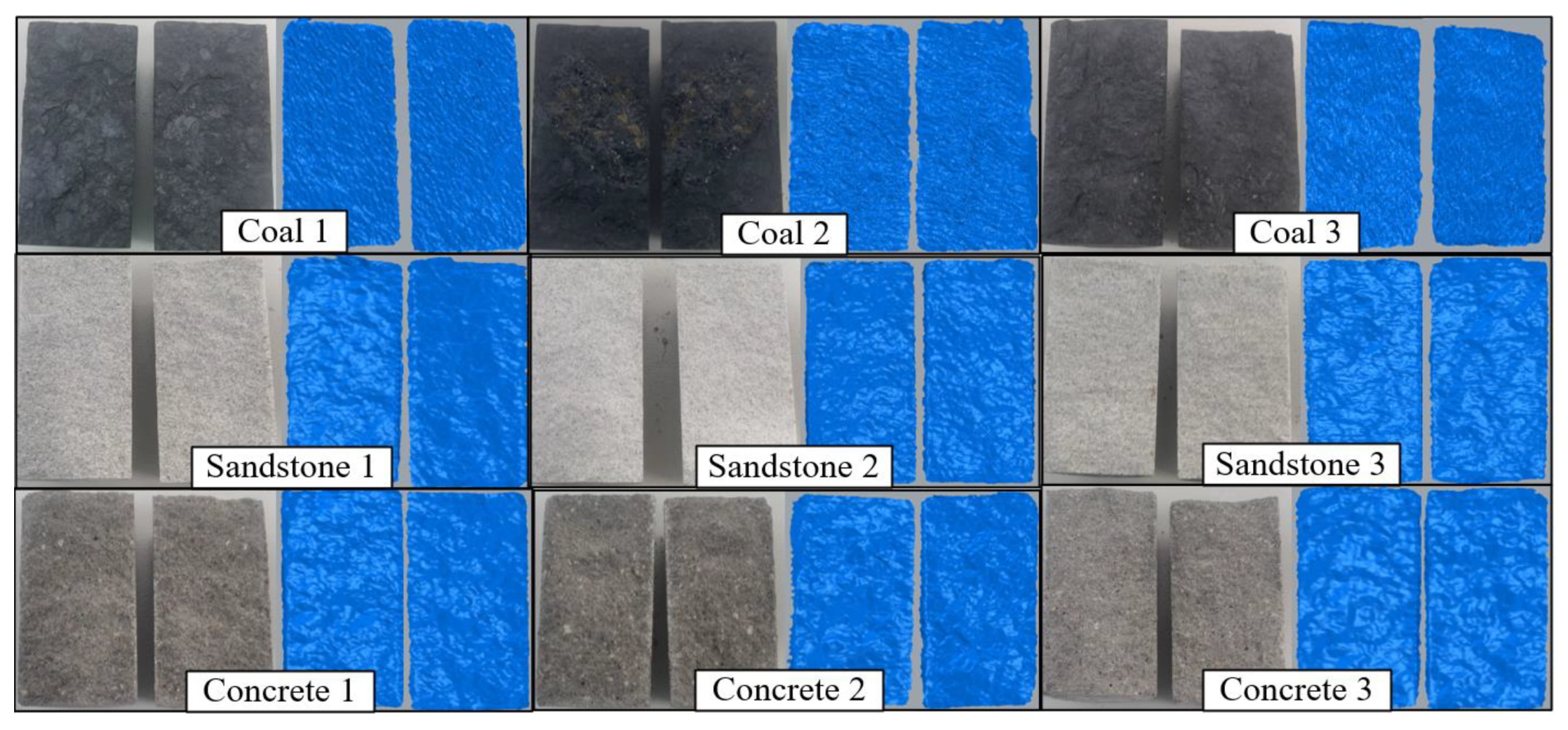

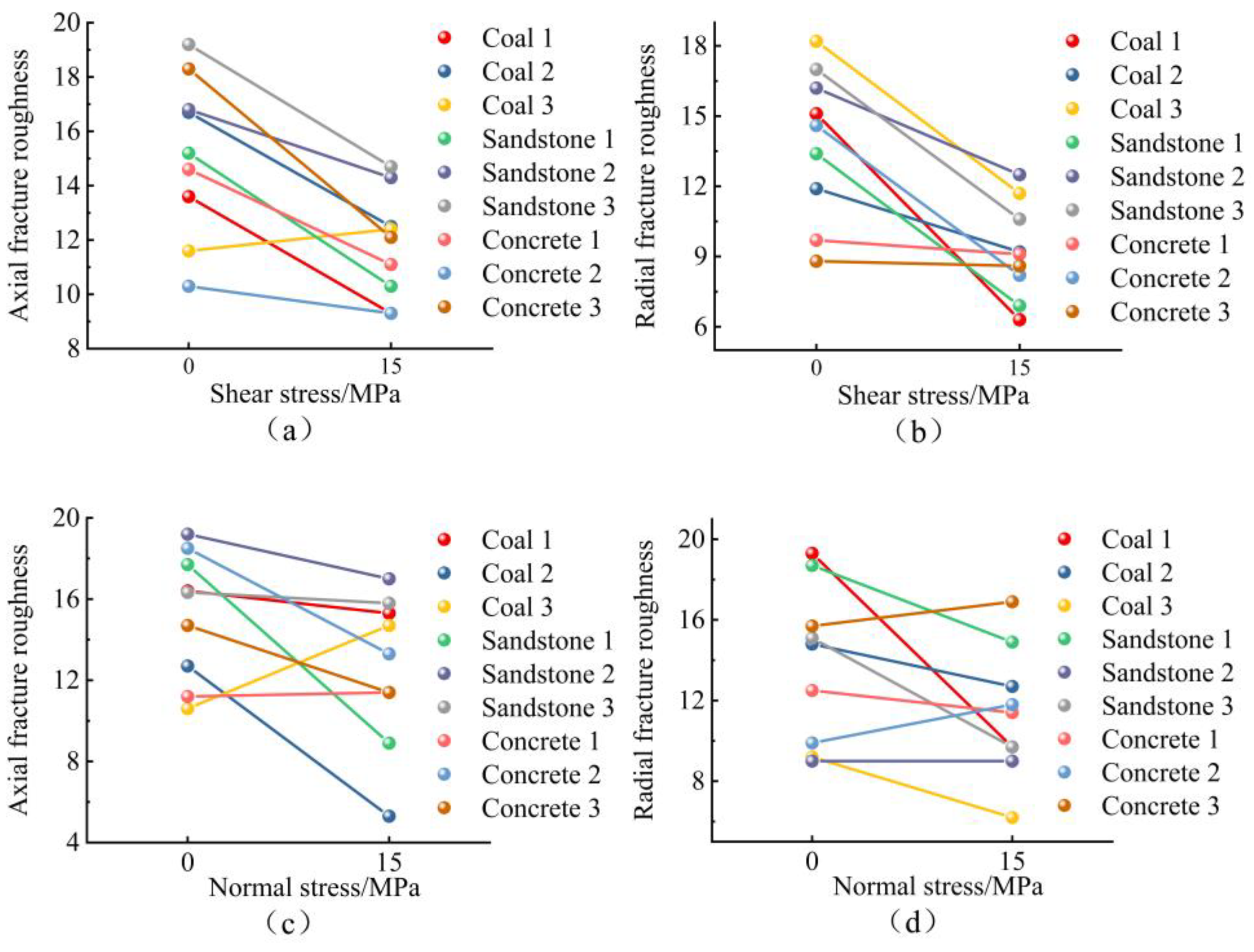



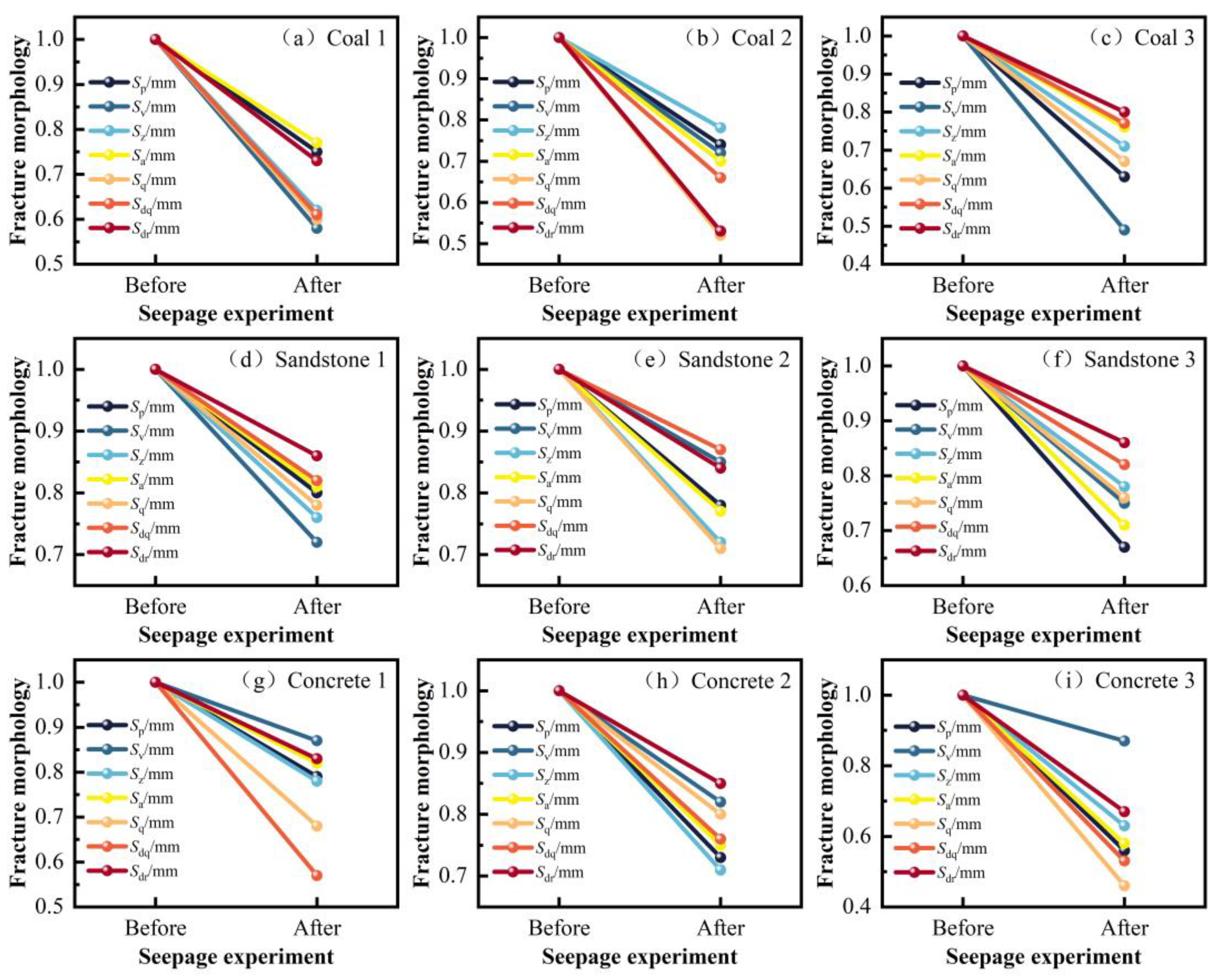

| No. | Sample | Seepage Pressure Pw (MPa) | Surrounding Pressure σ2, σ3 (MPa) | Axial Stress σ1 (MPa) |
|---|---|---|---|---|
| 1 | Coal 1 Coal 2 Coal 3 | 0.4, 0.5, 0.6 | 4.0 | 5.0, 7.0, 9.0, 11.0, 13.0, 15.0 |
| 2 | Sandstone 1 Sandstone 2 Sandstone 3 | |||
| 3 | Concrete 1 Concrete 2 Concrete 3 |
| No. | Shear Angle/° | Wrecking Load/kN | Peak Shear Strain | Axial Stress σn /MPa | Shear Stress τn /MPa |
|---|---|---|---|---|---|
| C1 | 55 | 50.93 | 0.0398 | 14.88 | 21.25 |
| C2 | 60 | 39.02 | 0.0443 | 9.94 | 17.21 |
| C3 | 65 | 43.29 | 0.0395 | 9.32 | 19.98 |
| S1 | 55 | 61.82 | 0.0444 | 18.06 | 25.79 |
| S2 | 60 | 42.61 | 0.0389 | 10.85 | 18.80 |
| S3 | 65 | 45.34 | 0.0496 | 9.76 | 20.93 |
| Ct1 | 55 | 26.04 | 0.0373 | 7.61 | 10.86 |
| Ct2 | 60 | 29.57 | 0.0356 | 7.53 | 13.04 |
| Ct3 | 65 | 25.13 | 0.0294 | 5.41 | 11.60 |
| Type of Rock | Coal | Sandstone | Concrete |
|---|---|---|---|
| Cohesion/MPa | 14.31 | 12.50 | 10.92 |
| Angle of Internal Friction/° | 24.43 | 35.92 | 7.63 |
| Sample | Before the Seepage Experiment | After the Seepage Experiment | ||
|---|---|---|---|---|
| Axial Roughness | Radial Roughness | Axial Roughness | Radial Roughness | |
| Coal 1 | 13.6 | 15.1 | 9.3 | 6.3 |
| Coal 2 | 16.7 | 11.9 | 12.5 | 9.2 |
| Coal 3 | 11.6 | 18.2 | 12.4 | 11.7 |
| Sandstone 1 | 15.2 | 13.4 | 10.3 | 6.9 |
| Sandstone 2 | 16.8 | 16.2 | 14.3 | 12.5 |
| Sandstone 3 | 19.2 | 17.0 | 14.7 | 10.6 |
| Concrete 1 | 14.6 | 9.7 | 11.1 | 9.1 |
| Concrete 2 | 10.3 | 14.6 | 9.3 | 8.2 |
| Concrete 3 | 18.3 | 8.8 | 12.1 | 8.6 |
Disclaimer/Publisher’s Note: The statements, opinions and data contained in all publications are solely those of the individual author(s) and contributor(s) and not of MDPI and/or the editor(s). MDPI and/or the editor(s) disclaim responsibility for any injury to people or property resulting from any ideas, methods, instructions or products referred to in the content. |
© 2023 by the authors. Licensee MDPI, Basel, Switzerland. This article is an open access article distributed under the terms and conditions of the Creative Commons Attribution (CC BY) license (https://creativecommons.org/licenses/by/4.0/).
Share and Cite
Shi, Z.; Yao, Q.; Wu, C.; Xu, Y.; Wang, F.; Wang, W.; Sun, J. Interaction between Groundwater and Rock Fractures under Stress and Seepage Based on Extractive Water Resource Utilisation. Processes 2023, 11, 3380. https://doi.org/10.3390/pr11123380
Shi Z, Yao Q, Wu C, Xu Y, Wang F, Wang W, Sun J. Interaction between Groundwater and Rock Fractures under Stress and Seepage Based on Extractive Water Resource Utilisation. Processes. 2023; 11(12):3380. https://doi.org/10.3390/pr11123380
Chicago/Turabian StyleShi, Zhuolin, Qiangling Yao, Chengle Wu, Yingnan Xu, Furong Wang, Weinan Wang, and Jialong Sun. 2023. "Interaction between Groundwater and Rock Fractures under Stress and Seepage Based on Extractive Water Resource Utilisation" Processes 11, no. 12: 3380. https://doi.org/10.3390/pr11123380
APA StyleShi, Z., Yao, Q., Wu, C., Xu, Y., Wang, F., Wang, W., & Sun, J. (2023). Interaction between Groundwater and Rock Fractures under Stress and Seepage Based on Extractive Water Resource Utilisation. Processes, 11(12), 3380. https://doi.org/10.3390/pr11123380






